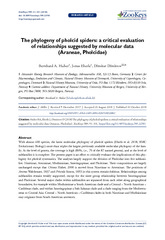The phylogeny of pholcid spiders: a critical evaluation of relationships suggested by molecular data (Araneae, Pholcidae)
Peer reviewed, Journal article
Published version

Åpne
Permanent lenke
https://hdl.handle.net/1956/20560Utgivelsesdato
2018-10-10Metadata
Vis full innførselSamlinger
Originalversjon
https://doi.org/10.3897/zookeys.789.22781Sammendrag
With almost 600 species, the latest molecular phylogeny of pholcid spiders (Eberle et al. 2018, BMC Evolutionary Biology) more than triples the largest previously available molecular phylogeny of the family. At the level of genera, the coverage is high (86%, i.e., 75 of the 87 named genera), and at the level of subfamilies it is complete. The present paper is an effort to critically evaluate the implications of this phylogeny for pholcid systematics. The analyses largely support the division of Pholcidae into five subfamilies: Ninetinae, Arteminae, Modisiminae, Smeringopinae, and Pholcinae. Their compositions are largely unchanged except that Chisosa Huber, 2000 is moved from Ninetinae to Arteminae. The positions of Artema Walckenaer, 1837 and Priscula Simon, 1893 in this system remain dubious. Relationships among subfamilies remain weakly supported, except for the sister group relationship between Smeringopinae and Pholcinae. Several major clades within subfamilies are separated from each other along geographical boundaries; for example within Modisiminae a South American clade and a Central + North American + Caribbean clade, and within Smeringopinae a Sub-Saharan clade and a clade ranging from the Mediterranean to Central Asia. Central + North American + Caribbean clades in both Ninetinae and Modisiminae may originate from South American ancestors.
